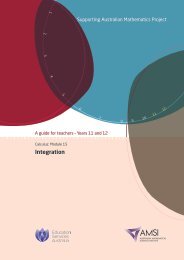Probability - the Australian Mathematical Sciences Institute
Probability - the Australian Mathematical Sciences Institute
Probability - the Australian Mathematical Sciences Institute
- No tags were found...
You also want an ePaper? Increase the reach of your titles
YUMPU automatically turns print PDFs into web optimized ePapers that Google loves.
A guide for teachers – Years 11 and 12 • {41}Answers to exercisesExercise 1aA, C , D and E are all events, because <strong>the</strong>y each consist of a collection of possibleoutcomes. B is not an event for this random procedure, because if we only know <strong>the</strong>outcome of <strong>the</strong> roll of <strong>the</strong> dice, we do not know whe<strong>the</strong>r or not B has occurred.b A = {(1,1),(1,2),(2,1),(1,4),(4,1),(2,3),(3,2),(1,6),(6,1),(2,5),(5,2),(3,4),(4,3),(5,6),(6,5)}.c |D| = 11.d A ∩ E = ∅, <strong>the</strong> empty set. None of <strong>the</strong> possible outcomes is in both A and E: <strong>the</strong>re isonly one outcome in E, and it is clearly not in A (since 6+6 = 12, which is not prime).Exercise 2For this random procedure, each possible outcome consists of an ordered sequence of31 numbers, such as (0.1,1.2,0.7,3.4,...). The first number is <strong>the</strong> rainfall on 1 August,<strong>the</strong> second is <strong>the</strong> rainfall on 2 August, and so on. There are infinitely many possibleoutcomes, in principle. Cases like this are not at all unusual. Any time we take a sequenceof measurements of a quantity of interest, we have a random procedure of this type.a i We know which dates are Mondays in August 2017. So, if we have observed anoutcome, we can determine whe<strong>the</strong>r or not A has occurred. Thus A is an event.ii Although B seems related to rainfall, it is not an event for this random procedure.For any given outcome, we cannot say for sure whe<strong>the</strong>r B has occurred.iii The outcomes in C are those sequences for which <strong>the</strong> sum of <strong>the</strong> 31 numbers(<strong>the</strong> daily rainfall amounts) is greater than 20.0. Thus C is an event.b The pairs of mutually exclusive events are: A and F ; E and F .c i A ′ = “<strong>the</strong>re is a rainfall amount greater than zero recorded on at least one daythat is not a Monday”.ii A ∩ E = “ei<strong>the</strong>r no rainfall is recorded for <strong>the</strong> whole month, or else <strong>the</strong> only daywith a rainfall amount greater than zero is <strong>the</strong> last Monday of <strong>the</strong> month”.iii A ∪ C is a complicated event to put in words: <strong>the</strong> best way of describing it isto say that ei<strong>the</strong>r A occurs, or C occurs, or both. An example of an outcomethat is not in A ∪ C is rainfall of 0.1 mm every day; for such an outcome <strong>the</strong>reis non-zero rainfall on days o<strong>the</strong>r than Mondays (so A does not occur) and <strong>the</strong>total rainfall for <strong>the</strong> month is 3.1 mm (so C does not occur). Since nei<strong>the</strong>r A norC occurs, <strong>the</strong> union A ∪C does not occur for this outcome.
















